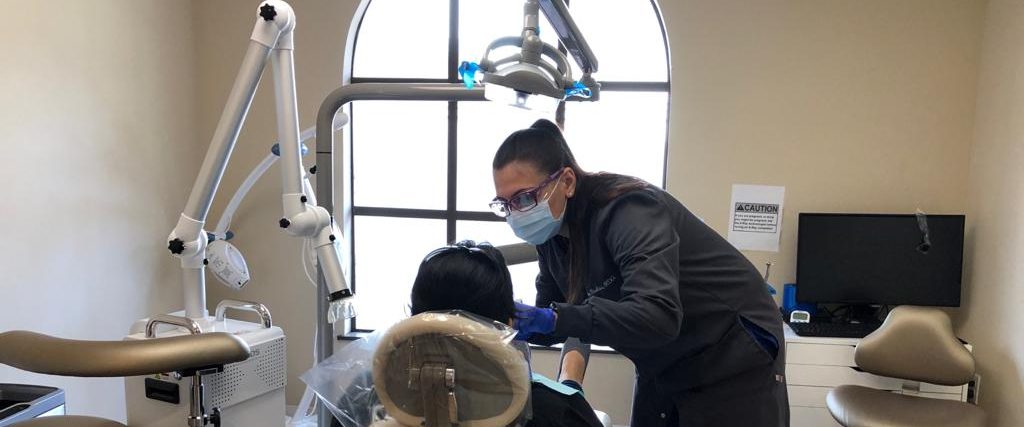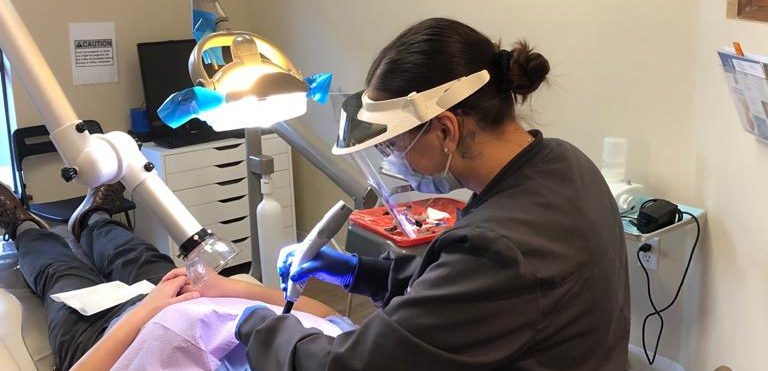Date : 17/06/2020
We all know it’s easy to take our teeth for granted if they don’t hurt or cause us any problems. However, what we might need is a tooth sealant to keep them strong and healthy.
It’s not always apparent that preventive dentistry is necessary. But you’ll know it when a cavity shows up, or worse yet, you need a root canal. The truth is that going to the dentist for regular checkups will help you determine if you need a tooth sealant.
If you look at your back teeth, or molars, you’ll notice the surface isn’t flat. Instead, molars have pointy peaks and valleys, which makes them difficult to clean with a toothbrush and floss. These hard to reach, uneven surfaces are one reason that you may want to consider using a tooth sealant.
Molars Are a Challenge
We use the term molars to describe the flat, wide teeth that help us chew our food up so we can digest it properly. Our molars take up most of our mouth compared to a total of eight incisors and four canine teeth, which are for ripping and tearing our food. Between baby teeth and permanent teeth, there are a total of eight incisors and four canine teeth.
There are eight pre-molars we get as children, and those teeth are replaced later with twelve permanent molars. That’s a lot of vulnerable surface area for tooth decay. Consequently, molars are where we most likely use tooth sealants.
Those sealants are useful at an early age, as we can potentially carry the decay from our primary baby teeth to our permanent adult teeth.
Decay and Tooth Sealants
Did you know that up to 90 percent of school-aged children have dental problems? A large number of adults do as well. What’s more, it’s not only one, but many factors that cause tooth decay or dental caries.
First of all, tooth decay happens when our enamel is weakened and gets soft. We know that enamel is the hardest mineral in our body and the natural sealant that protects our teeth. Although it’s supposed to be tough, our teeth get a workout every day from chewing. In other words, our enamel erodes because we eat.
But that’s just part of the story
This demineralization of our teeth’s protective surface, or softening of our enamel, is the result of plaque, bacteria, and acid generated by the sugars in our food and drinks. Genetics or other factors, such as mouth trauma or illness also cause soft enamel.
Inevitably, our enamel erodes, even if our teeth are healthy.
No doubt about it, no matter how well we brush our teeth, and floss between them, we can’t always get to those areas that are vulnerable to decay.
Bacteria and plaque lead to weakened enamel
So all those hard to reach areas in the back of our mouths are in danger of losing their natural protection. Simply stated, germs can infiltrate the more sensitive parts of our tooth, causing deep decay and gum disease.
What Is a Tooth Sealant?
Adding a tooth sealant is preventive dentistry that acts as a safety measure to defend against the processes that cause tooth decay. Not to mention, tooth sealant costs less than restorative dentistry and is a quick and straightforward procedure.
Dental sealants fill in the gaps and smooth the tooth’s surface, providing a protective coating and preventing trapped debris from causing decay. Sealants also ease much of the wear and tear of chewing.
Benefits of tooth sealant
One of the benefits of adding a tooth sealant is that it’s a painless procedure that will also save you pain in the long run. Not only that but these dental procedures could save you a significant amount of time and money as well.
And best of all, tooth sealants work for both children and adults. That’s why we think tooth sealants are an excellent option for protecting your teeth from tooth decay.
Placing the Tooth Sealant
You’ll get your dental sealants finished in a single dental visit. Once the dentist prepares the tooth, there are only a few more steps to get the job done.
1. Cleaning the tooth surface
The dentist or hygienist cleans the tooth surface before applying the sealant. Think of it as a powerwash that prepares your tooth for the application.
2. Drying the tooth
Then the dental professionals use air to get the tooth as dry as possible. Pressurized air ensures the tooth is thoroughly dried and improves the bond between the tooth and the sealant.
3. Tooth preparation
Next, a gel-like substance is applied, which roughens the surface of the tooth. The gel stays on the tooth for about 30 seconds to a minute, and then you get a rinse. You see, a rough surface helps the sealant adhere well to the tooth and increases its penetration into deep grooves and crevices on the tooth’s surface.
4. Tooth sealant application
Once the tooth is clean, dry, and roughed-up, the dentist applies the tooth sealant. The resin they use is either transparent or colored, and it usually activates with a special ultra-violet light. Some sealants change color with the light activation to show they are fully set.
After the sealant is applied
You may notice that your treated tooth feels different from your natural teeth after the procedure. The treated area feels smooth when you touch it with your tongue, and there could be some pressure as the resin settles. Any mild discomfort should pass quickly.
If for some reason your tooth sealant feels uncomfortable after placement, it’s essential to let your dentist know right away.
5 Reasons to Get a Tooth Sealant
As we’ve discovered, dental sealants are an effective method to prevent tooth decay in both children and adults. Any number of things can cause weak enamel — genetics, habits, and illness all play a part in our oral health.
1. Poor enamel formation
Sometimes baby teeth or adult teeth grow in with no enamel. Similarly, there are times when the growth of this protective coating is hindered and weak. Each person’s teeth develop enamel at different rates as well as different thicknesses.
Genetics is one reason for the condition, known as enamel hypoplasia, in which the enamel is malformed or non-existent. Another known cause is a mother’s lack of proper nutrition during pregnancy. Likewise, if an infant doesn’t get the nutrients they need while they’re in this early growth stage, it will likely affect their teeth.
Additionally, some medications that a woman requires during pregnancy can cause the poor formation of enamel. And if there is an injury causing trauma to the teeth or jaw, it is potentially a threat to the formation of enamel.
2. Soft enamel
Sometimes the enamel is there, but it doesn’t contain the right amount of minerals. Therefore, it turns soft, which is a condition known as enamel hypomineralization. There are outside factors as well as internal issues that may lead to soft enamel.
As it turns out if your diet doesn’t provide proper nutrition, you risk enamel hypomineralization. Conversely, if for some reason your body can’t process nutrients, the chance of your enamel softening is also a problem.
3. Medical conditions
Unfortunately, many medical conditions affect our oral health. As we mentioned, if your body can’t process what it needs to keep your enamel strong, you may need a tooth sealant.
One culprit is Celiac disease, which can result in small intestine damage that hinders the absorption of nutrients. Other medical conditions such as kidney disease, diabetes, and high blood pressure are also culprits in degrading our enamel.
Acid reflux is a tricky one. If you experience the burning, nasty taste rising in your throat, you’ll likely want to brush your teeth right away. This makes sense, of course. As it turns out, brushing right away is the wrong action to take. The acid makes our enamel soft, and brushing poses the danger of damaging the enamel further. Instead, it’s best to rinse out your mouth with water and let your teeth settle down after an acid reflux attack.
4. Protection for uneven surfaces
Even the best brushing procedures may not remove the debris from the deep fissures of our molars. Tooth sealants seal off the tooth surface and smooth out those problem areas. Pit and fissure sealants are common because of the problems we discussed earlier with our ability to clean our molars properly.
Children are the most susceptible since they haven’t yet mastered the art of brushing their teeth. Don’t let that fool you though; many adults have the same challenge. It’s estimated that 80 percent of the tooth decay we experience happens due to food accumulation in the crevices of our teeth.
You can see why using preventive dentistry such as a tooth sealant would help cut down on this well-known reason for dental caries.
5. Inadequate oral hygiene
No doubt about it, some teeth are more prone to decay because they’re crooked or bunched together, hindering proper oral hygiene. Baby teeth are also in danger because they’re small and difficult to clean.
Tooth sealants deter the risk of dental caries when your child’s primary teeth make way for their permanent counterparts.
Safe and Sealed
Ultimately, tooth sealants may be the solution to avoiding complex dental problems. There’s no need to risk dental pain, infection, and the high costs of restorative dentistry. Plus, they blend well with the natural color of your teeth.
Your teeth are a part of you that you want to last a lifetime. To that end, you do what you can to keep your teeth healthy. The problem is, it’s not always easy to protect your enamel no matter how hard you try.
So many things affect our oral health, from what we put in our mouths, to the genetics we inherited, and even the medications we must take for other ailments.
If you think you’re one of the people who could benefit from tooth sealant, maybe it’s time to consult with one of the team members at Your Caring Dentist Group to find out how we can help you preserve your smile for a lifetime.




